Exhibitions cancelled, art fairs postponed, sales stalled: with their activities paralyzed, photo galleries, already struggling over the past years, are tackling the future one day at a time.

You’re getting blind.
Don’t miss the best of visual arts. Subscribe for $9 per month or $108 $90 per year.
Already suscribed ?



